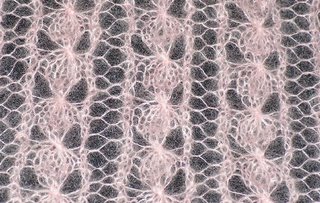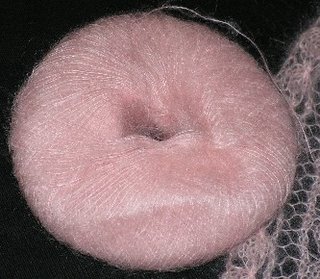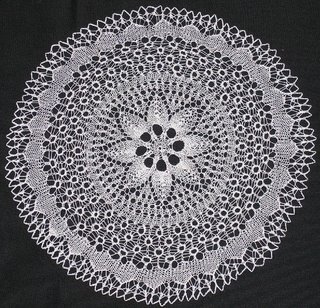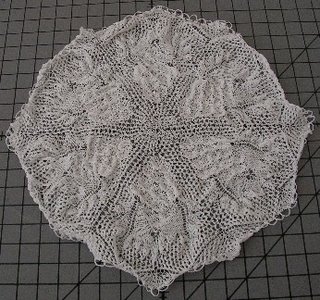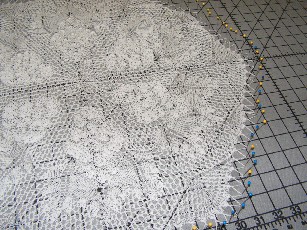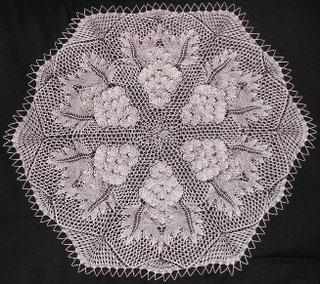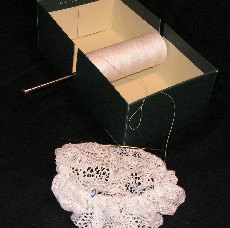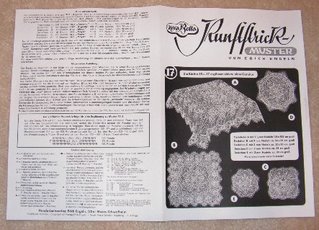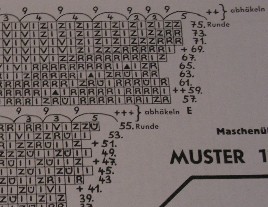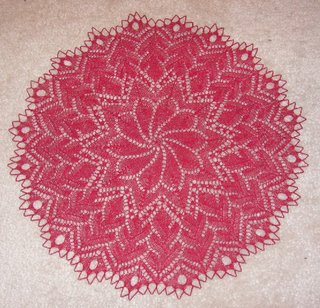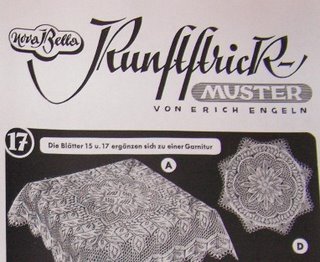There are many doily patterns available in English, including Marianne Kinzel’s first and second books, Gloria Penning’s six books, and Knitted Lace by Sonja Esbensen and Anna Rasmussen. A doily-obsessed knitter could get along quite well working from those books alone. However, there are also many interesting patterns that are only available in German. I have a sneaking suspicion that there are knitters who have German lace patterns, or even collect them, but have never knit from one. I was one of those people for a long time! However, I think it’s getting easier and easier for me with every doily I’ve worked. It's not hard to work out a charted German lace knitting pattern—there isn't that much text.
Note #1: There’s a knitter’s dictionary called Knitting Languages by Margaret Heathman. I have the first edition; perhaps the second edition is better. For me, its usefulness was limited and could only give me a start with translating a few terms in lace patterns. I put together the information in this post mainly by correlating many different German publications with some English-language Burda publications and my own knitting experience.
Note #2: This guide is primarily designed as a guide to German lace knitting patterns, which are almost always largely based on a chart. I can't necessarily help you to decipher, say, written-out German instructions for knitting a short-row sock heel, because I can't actually read larger sections of German text.
Note #3: Don't forget that there are awesome groups on the web like Laceknitters on Yahoo Groups that have knowledgeable members from around the world who are always willing to help with translations (as well as all kinds of other lace knitting issues!).
We'll start with patterns for knitting a basic doily or tablecloth in the round that is essentially a circle or a regular polygon knitted from a point in the center (not an oval, oblong, or rectangle). Ok, I'm assuming that if you are interested in working out how to read German doily patterns, you have knit at least one before from a pattern in a language that you did know how to read. So, you probably already know that the instructions for a round doily almost always go something like this:
1) Cast on X number of stitches in the round. Divide stitches onto dpns, etc.
2) Follow the chart. All rounds that are not spelled out on the chart, knit around.
3) Make sure you have knit one more plain round after the last pattern round, then cast off by grouping the stitches with single crochet and making crochet chains of Y number of stitches between them. Block.
The trick is to simply work out the key to symbols in the chart. First, the basics:
1 Umschlag = yarn over
1 Masche rechts = knit 1
1 Masche links = purl 1
1 Masche rechts verschränkt = knit 1 through the back loop
2 Maschen rechts zusammenstricken = knit 2 together
1 Masche abheben, die folge Masche rechts stricken, die abgehobene Masche darüberziehen = slip 1, knit 1, pass slipped stitch over
From the above, you can also see that:
Masche or Maschen refers to "stitch" or "stitches" in general
rechts refers to "knit stitch"
links refers to "purl stitch"
verschränkt refers to "through the back loop"
zusammenstricken refers to "together"
abheben refers to "slip"
die abgehobene Masche darüberziehen refers to "pass slipped stitch over"
If you are aware of just these basic terms, you can work out more. For example, take a guess at "1 Masche abheben, 2 Maschen rechts zusammenstricken, die abgehobene Masche darüberziehen." It's slip 1, knit 2 together, pass slipped stitch over. Or how about this abbreviation: "1 M. re." It's 1 Masche rechts, or knit 1.
Here is a more complete list. It's a work in progress, and I'll be adding to it from time to time. Right now, I’m focusing only on the most common stitches in lace knitting—like yarn overs and decreases. I might cover other stitches like cables later.
If you find errors or have other concerns, please, please leave comments!
German-English Knitting Translations
| German knitting terms (with alternate text) | German abbreviations | English knitting terms |
| 1 Masche rechts (1 Masche rechts stricken) | 1 M. rechts/1 M. re. | knit 1 |
| 1 Masche links (1 Masche links stricken) | 1 M. links/1 M. li. | purl 1 |
| 1 Masche rechts verschränkt (1 Masche rechts verdreht stricken indem man sie von inhrer Mitte nach hinten hin abstrickt) | - | knit 1
through the back loop |
| 1 Masche links verschränkt | - | purl 1 through the back loop |
| 1 Umschlag | 1 U. | 1 yarn over |
| 2 Maschen rechts zusammenstricken (2 Maschen rechts zu einer Masche zusammenstricken) | 2 M. r. zusammenstr/2 M. r. zusstr. | knit 2 together |
1 Masche abheben, die folge Masche rechts stricken, und die abgehobene Masche darüberziehen (1 Masche abheben, dann 1
Masche rechts stricken, und die abgehobene Masche überziehen) | - | slip 1-knit 1-pass slipped stitch over |
| 2 Maschen rechts verschrankt zusammenstricken | - | knit 2 together through the back loops |
| 3 Masche rechts zusammenstricken | 3 M. r. zusammenstr. | knit 3 together |
| 1 Masche abheben, 2 Maschen rechts zusammenstricken, die abgehobene Masche darüberziehen (1 Masche abheben, dann 2 Maschen rechts zusammenstricken und die abgehobene Masche über diese zusammengestrickte Masche ziehen) | 1 M. abheben, 2 M. rechts zusammenstr., die abgehobene M. darüberziehen | slip 1-knit 2 together-pass slipped stitch over |
| 2 Maschen abheben, dann 2 Maschen rechts zusammenstriken und die 2 abgehobenen Maschen über die zusammengestrickte Masche ziehen | - | slip 2-knit 2 together-pass 2 slipped stitches
over |
| 1 Masche rechts verschränkt aus dem Masche-Querdraht herausstricken | - | make 1 by lifting the thread between two stitches and knitting it through the back loop |
| aus 1 Masche, 2 Maschen stricken [1 Masche rechts, 1 Masche links] | - | [knit 1, purl 1] into the same stitch |
| 1 Masche wie zum Linksstricken abheben | - | slip 1 purlwise |
1 Masche wie zum
Rechtstricken abheben | - | slip 1 knitwise |
x Maschen
anschlag | x M. anschl. | cast on x stitches |
x
Luftmaschen | x Lftm./x Lm. | x-stitch crochet chain |
In any language, there are always several ways of saying the exact same thing, and so your German knitting pattern might not use these exact same words. I have tried to provide some alternate German wording as well as possible abbreviations for some of the terms.
Note that for now I have deliberately not matched up these knitting terms to any specific list of symbols from a German publication (like an Anna/Burda magazine, or a Diana/Lea magazine). In my opinion, if you want to really want to get into the multitude of German lace knitting patterns out there, it's best to learn to recognize the actual knitting words that will appear in all of these publications regardless of the symbols used. Soon, you will be able to pick up any German knitting chart key and be able to at least work out the basic stitches from memory. Also, in order to have a better shot at understanding abbreviations you may encounter in German patterns, you should be familiar with what the words might be. If you've never seen "1 Masche rechts" before, it can be difficult to get what "1 M re" is since you can't look up that term in a dictionary.
Special situations in lace knitting patterns
Casting on and crocheting off
| German | German abbreviations | English |
x Maschen
anschlag | x M. anschl. | cast on x stitches |
x
Luftmaschen | x Lftm./x Lm. | x-stitch crochet chain |
Instructions for casting on will either appear near the beginning rounds of the chart or in the notes to the pattern—look for “anschlag.” At the end of the pattern notes, look for “Luftmaschen” or numbers above the final round of the chart. In an Engeln pattern, for example, there are two rows of numbers of above the final round—the lower numbers are how many stitches to group with single crochet, the upper numbers are how many stitches to chain in between groups. It also helps to know that “häkeln” means “crochet” (and “stricken” means “knitting”).
Making stitches into multiple yarn overs
Multiple yarnovers (such as [yo]x3) in a pattern round are usually treated on the following round by either working [knit 1, purl 1, alternating] or [knit 1, knit 1 through the back loop, alternating] into the multiple yarnover. The number of stitches worked into the yarnover varies depending on the lace pattern and is not always the same as the number of yarnovers made. For example, a pattern might say: [yo]x3 in one round, then work [k1, p1, k1, p1, k1] into the yos in the following round.
There are several ways to describe this situation in a pattern. One is to simply show multiple yarn over symbols in the pattern round, then explicitly spell out the next plain round in the chart with [k1, p1] or [k1, k1tbl] symbols where necessary above the yarn over symbols. Another way is to provide special written instructions in the accompanying text (e.g., "In round 54, make 12 stitches into the yarnovers by alternating k1, k1tbl”). Other times, a chart will have a big complex-looking symbol in a pattern round that represents a multiple yarn over and the stitches made into it on the next round (e.g., in the symbol key, you might see “Yarn over 3 times and in the next round, make 18 stitches into the yarn overs by alternating k1, p1”).
I can't list every possible example here, but the key is to figure out how the pattern you have describes what to do about multiple yarn overs, and then from the following translations you should be able work out much of what is specified.
| German | German abbreviations | English |
| Umschlag | U. | yarn over |
| 1 Masche rechts, 1 Masche links | 1 M. re., 1 M. li/rechts-links/r.-l. | knit 1, purl 1 |
| 1 Masche rechts, 1 Masche rechts verschränkt | 1 M. re., 1 M. re verschränkt | knit 1, knit 1 through the back loop |
| abwechselnd | - | alternating |
| folge Runde | folg. Rd. | next round |
Shifting the beginning of the round left or right
Sometimes in the chart, a symbol will appear next to the round number indicating to shift the start of the rounds by a certain number of stitches right or left. The symbol will either include a number (such as “3 Mv” in Burda patterns) or be repeated for how many stitches (such as “+++” in Engeln patterns).
There are different ways to describe this situation in a symbol key, so it can be hard to see exactly which symbol means shift right and which symbol means shift left. Some examples from Burda and Engeln publications:
Before the beginning of the round, slip the first stitch from left needle to right needle (or knit an additional stitch) to shift the beginning of the pattern to the left:
Burda: nach dem Ende der Zwischenrunde die Zwischen runde eine Masche weiter stricken
Engeln: vor einer Runde bedeutet, daβ die erste Masche der Runde auf die vorhergehende Nadel abgestrickt wird
Before the beginning of the round, slip the last stitch from the right needle to the left needle (or don’t work the last stitch) to shift the beginning of the pattern to the right:
Burda: die Zwischenrunde 1 Masche vor dem Schluβ der Runde beenden
Engeln: die letzte Masche der vorhergehenden Runde auf die nächste Nadel herübergehoben wird
If you haven’t been able to work out the exact translation, just look at your knitting to see which direction to shift makes more sense.
Columns of twisted or purled stitches
The pattern notes might further indicate is what do to in the plain rounds when the pattern rounds make a column of twisted stitches, purls, 1x1 crossed stitches, etc. The middle vein through a lace leaf shape, for example, might be column of twisted stitches in the pattern rounds. Well, I would just keep doing whatever the stitch is in the intervening plain rounds (twist the twisted stitches, purl the purled stitches, etc), no matter what it said in the notes (gasp!!). I think I have encountered instructions in German patterns that do specify maintaining twisted stitches in plain rounds, but until I am certain, I don’t have examples to list here right now.
Pattern repeats
Sometimes the text will also note something like "From rounds 1-52, the chart is repeated 5 times in each round. From rounds 53-76, the chart is repeated 10 times in each round." Think of a doily having ten petal shapes repeated in the center which grow into twenty leaf shapes repeated around the outer perimeter (hint: see Egeblad!). As you can probably see, this information isn't critical to knitting the doily, since the way the pattern repeats itself around the doily is usually evident as you knit the pattern (or, just look at the picture of the finished pattern).
Finding all the pieces of the pattern
Sometimes if the pattern chart isn’t obviously right next to the photo of the doily, it helps to know “seite” means “page,” and “bogen” or “musterbogen” means “pattern sheet.”
Non-round doilies
What about oval, rectangular, or oblong doilies that aren't just knitted around and around a center point? Yes, the pattern notes will have some instructions on how to do that. But I will have to go into those issues in a later installment, as I think I've crammed enough into this post! The stuff above should give you enough info to knit a round doily or cloth, though, so if you haven’t tried a German pattern yet, just go for it!









